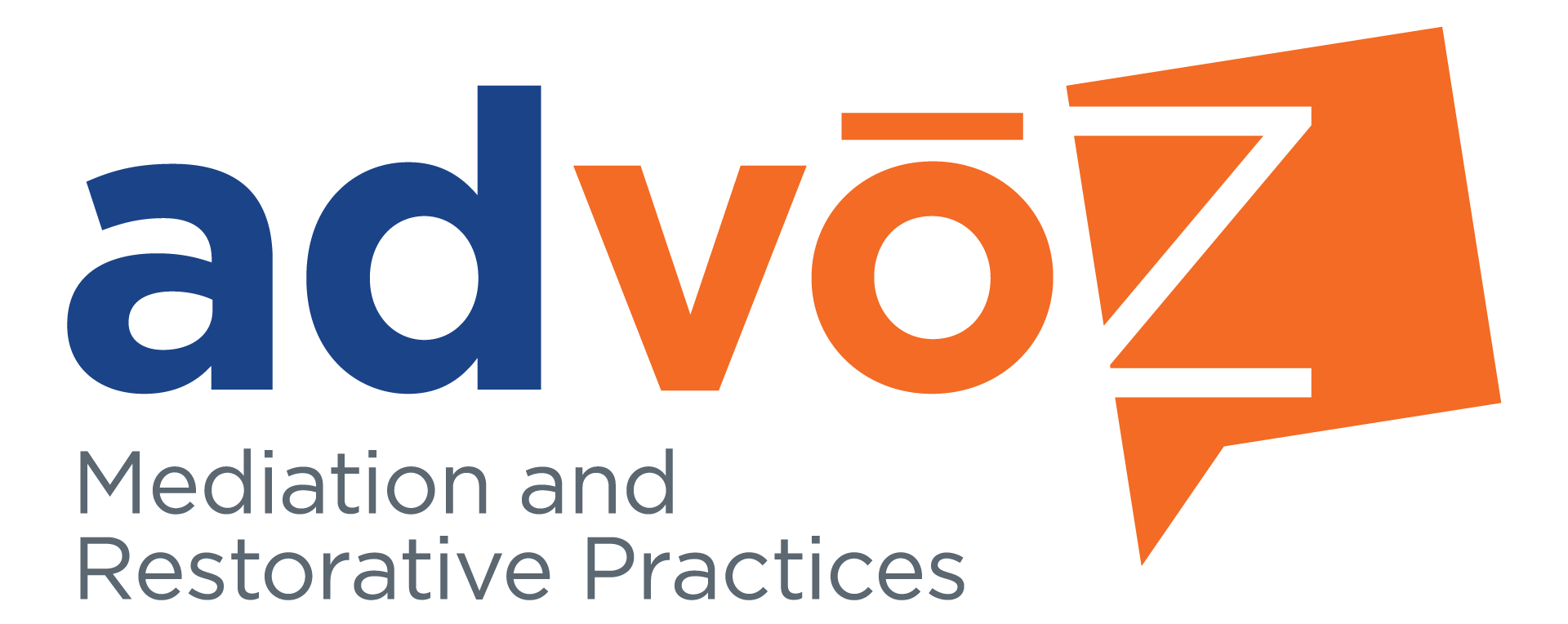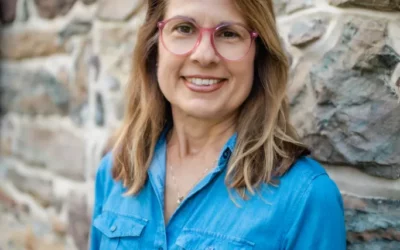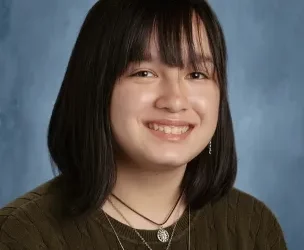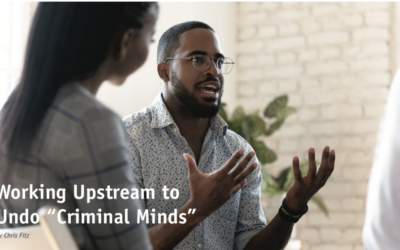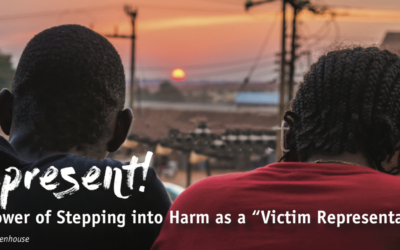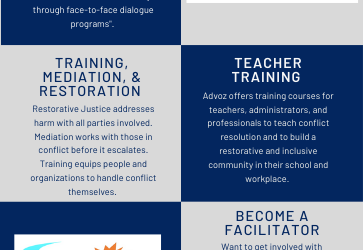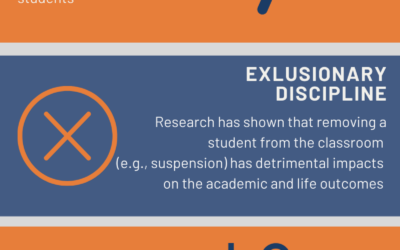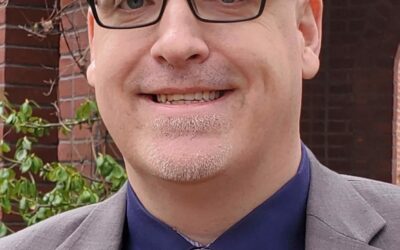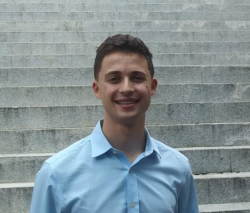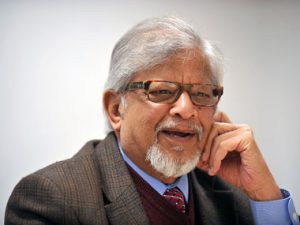The Advoz Blog
Stories of resolution, healing and more
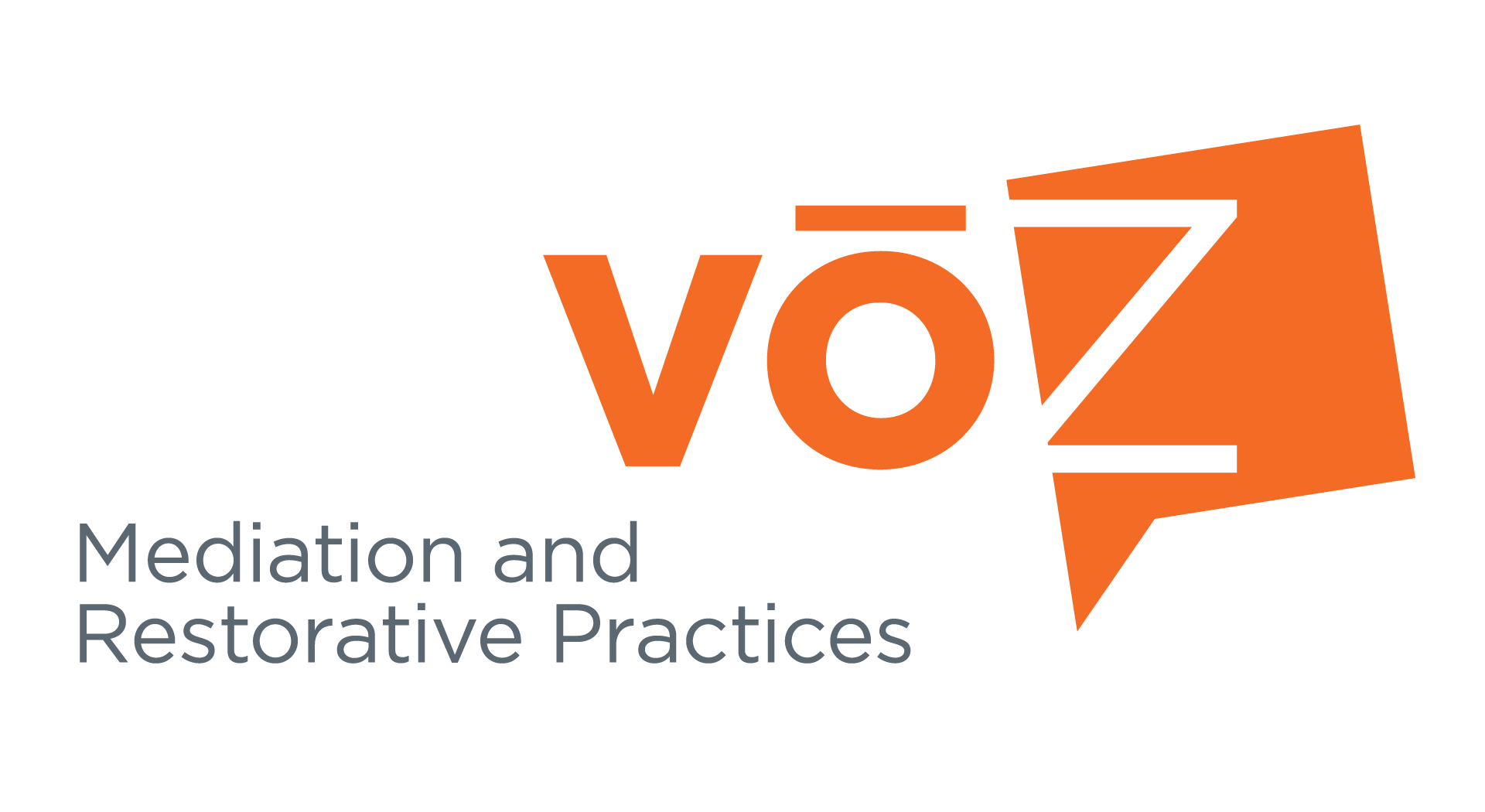
Read more about the work of Advoz in mediation, restorative practices and education for a more connected community.
Even More to Appreciate – Lydia’s internship learning 4 years later
We were honored to welcome Lydia Tamrat to our team as an intern several years ago. Those of you connected to Advoz lately may remember Lydia who interned through the Shalom Project. Lydia stood out as a rock-star intern, excelling in nearly every aspect of the work....
Life Learning as an Advoz Intern – Kaylee Geesey
Kaylee Geesey interned with Advoz in the spring of 2024 in conjunction with Millersville University's Social Work program. As I reflect on the time spent with Advoz, I am filled with gratitude and humbled at the growth I have seen in myself. I am the first person in...
Role-Modeling Restorative Practices
As I write this blog, I am in my ninth week of interning with Advoz: Mediation & Restorative Practices. It has been a healing experience for me to work with Advoz staff and volunteers because they center relationships in all aspects of their work. I have witnessed...
Interning for Mediation: Riley Sloat
I am Riley Sloat, and I am currently a senior at Elizabethtown Senior Highschool. I am interested in having a career as a mediator due to the business and Personal Law class I took in my sophomore year, wherein part of the curriculum was to do a mock...
Making Peace Workshop Referral
We just published an updated referral form for our Making Peace Workshop (below). As more partners in our juvenile justice system are again working in person, this is an incredibly valuable resource to build communication and conflict resolution skills in every...
Intern Stories: Meet Brelan Wilcher
harm caused within the community. In one way, it aims to achieve this by serving as a bridge that two or more individuals can cross to resolve conflicts through their mediation programs. The organization also partners with the Juvenile Justice System to speak with individuals who have caused harm to the community and help them take steps to make things right.
Working Upstream to Undo “Criminal Minds”
By Chris Fitz "Matthew” was only 13 years old. But this wasn’t his first run-in with the law. In our meeting, he fluently relayed the ways that adults in his neighborhood called the police about him—and how those complaints added up. He used terms like “complaint,”...
Represent! The Power of Stepping into Harm as a “Victim Representative”
By Krista Rittenhouse Consider this question: What are the odds of success for a young man of 16, who already has a record, dark skin, is in a single-parent home, and has already experienced prison? We can agree, and research shows that he has an uphill battle. One...
On Collaboration
In the following post, I will explore what I learned about collaboration while creating the last two infographics in partnership with friends and Chris Fitz. This is the sequel to last week's blog post and the final in a series covering a new set of infographics....
On Creating Dialogue about Exclusionary Discipline in Education
Before I share what I learned while creating Zero Tolerance and Restorative Justice (RJ) in education for Advoz, allow me to introduce myself briefly. My name is Catherine Wise. I am a college student studying neuroscience and Spanish at the Texas Christian University...
Adjusting to Move Forward: 2019-20 Annual Report
As we reflect on the last 18 months, we want to thank each of you for helping Advoz arrive in 2021 in a stronger position than we were before COVID-19 first hit. Looking back to last year, right before the pandemic, we had experienced an organizational change with a...
Intern Stories: Meet Kiarelys Ortega-Balbuena
My name is Kiarelys Ortega I am currently attending Millersville University for my bachelor's in Social Work. I originally chose Millersville because of the close proximity to where I live. I help out my parents...
Intern Stories: Meet Stephanie Fabian
I am currently a senior at Millersville University majoring in Social Work and minoring in Spanish. Since I was a middle school student, I knew I wanted to help people and advocate for unheard voices of vulnerable populations. My mom and her siblings are from Puebla,...
Living in the Process: An Intern’s Investment
By Sara Crouch, Program Intern Restorative justice is first and foremost a process, rather than an outcome. That’s one of the major lessons that I learned as an intern with Advoz this fall. As someone used to learning new skills quickly, it took me a while to...
Getting to ‘Thank You’
Rewiring our Apologies…and Our Brainsby Chris Fitz We were getting to end of dialogue. The woman who’d been robbed expressed her grace, that she didn’t hold this against the boy in front of her—or his mom. He was 15, with older friends, saw her get out of her car,...
Advoz Release On Racism And Dialogue
The violent deaths of George Floyd, Breonna Taylor and so many other people of color, are tragic, unnecessary and unjust. In acknowledging that we all play a role consciously or subconsciously in the reality of our current position as a community and a nation, we vow...
Resources for Conversations about Racism
By Chris Fitz Racism is a loaded word. In Advoz's dialogue work, mediators often first ask, "how do you feel?" Then we ask, "what do you think?" So I'll ask you, reader, "what comes up for you when you hear the word 'racism?'" The volatility and lopsided experience of...
Adding Voices, Processing Racism
FOR IMMEDIATE RELEASE The violent deaths of George Floyd, Breonna Taylor and so many other people of color, are tragic, unnecessary and unjust. In acknowledging that we all play a role consciously or subconsciously in the reality of our current...
Chris Wenden Named New Executive Director
Written by the Advoz Board Advoz welcomes a new Executive Director, Chris Wenden, to focus on program expansion and development throughout Lancaster County. “To continue the mission and expand our work and role in the community, the Board of Directors has recruited...
Mission Empathy: Intern Reflections
By Melisa Betancur A phone call is easy to underestimate. Through my work at Advoz, I learned that a phone call is enough to help build transparency and trust with victims of crimes. The power of empathy flows during these conversations, and I feel the vulnerability...
Restorative Justice & a Tale of Two Schools
The graphic above illustrates the positive differences we can make when we consistently put in the time and energy to shift the culture of our institutions with a restorative justice lens. Changing our community's culture of conflict is no small goal, but it's a...
Advoz’s 2018-2019 Annual Report: Core Concentration
Restorative Justice Victim Offender Conferencing cases continue to be about half of Advoz's caseload, primarily referred from Lancaster County's Juvenile Probation and Juvenile Court. Your dollars were a long-term community investment as we concentrated on core...
A Voice of Welcome: Addrienne Whitfield
Advoz has a new friendly voice who could be answering your phone call; Addrienne Whitfield began in September as Advoz’s administrative assistant. She joins the organization from the travel and service industry where she brings extensive customer service experience...
Youth with a View: Insight from Romeero, Cultivating the Future of Lancaster
Vision for Lancaster Romeero Melendez is a young man referred to Advoz's restorative justice program after a graffiti incident handled by local police and a Youth Aid Panel. He sat down to speak with Advoz about his experience with the justice system in a community...
Cutting through the Buzz: Facilitating Summer Learning
By Jake Rauchberg There was a buzz in the room. Between my excitement for my first Advoz program and the white noise engulfing the space, I could barely hear myself think. But it wasn’t the sort of buzz that you normally hear when you walk into a church on the...
Peacebuilding across Generations: Elliot Martin
By Skyler Gibbon, Advoz Intern Hearing his father’s stories around the dinner table inspired Elliot Martin to get involved with Advoz. “It sounded beautiful. There are really important principles of restorative justice. Needing to address the harm in conflict is...
Spreading Peace Across Generations: Tim Martin
By Skyler Gibbon, Advoz Intern Meet Tim and Elliot Martin, a father son duo volunteering with Advoz. After years of conversations about cases around the dinner table, Elliot decided to try it out for himself this spring. He joined the victim offender conferencing...
Calling All Volunteer (Peace Makers)
There are many ways one can contribute their time and skills to this work at Advoz! Calls continue into our office: conflicts, crimes, broken relationships. Can you answer this call for peacemakers in our community? We are looking for volunteers to help community...
Welcome Krista Rittenhouse
Krista Rittenhouse got involved with Advoz training and volunteering in our Restorative Justice Conferencing program this spring. But she went above and beyond the call of duty by successfully reaching out to dozens of people impacted by crime and violations on the...
Making Peace ~ Poetry & Practice
Each month, youth and parents have a chance to practice being peacemakers in their own world, family, school, friends, community. It's a class called Making Peace and the youth, often referred by Youth Aid Panels from school fights and other first-time incidents,...
New Faces: Jake Rauchberg, Advoz Summer Intern
We welcome Jake Rauchberg this summer from Franklin and Marshall College and the Ware Institute for Civic Engagement. He's joined Advoz this summer as a full-time intern, assisting in both programs and community outreach. Welcome Jake! What do you study? I am rising...
New Faces: Jake Rauchberg, Advoz Summer Intern
We welcome Jake Rauchberg this summer from Franklin and Marshall College and the Ware Institute for Civic Engagement. He's joined Advoz this summer as a full-time intern, assisting in both programs and community outreach. Welcome Jake! What do you study? I am rising...
New Faces: Skyler Gibbon, Advoz Summer Intern
We welcome Skyler Gibbon this summer from Lancaster and Millersville University. She learned about Advoz through our network of partners and mentors and has joined Advoz this summer as our full-time program intern. Welcome Skyler! What do you study? I am an English...
Kind Words, Kind Hands, Kind Feet: Fair Process for 3- or 93-year-olds
By: Mila Pilz, Advoz's Executive Director, Program Operations One of the basic tenets of restorative practices is called "fair process." "People are happier, more cooperative and productive, and more likely to make positive changes in behavior when those in authority...
Advoz Names New Officers
We are pleased to announce a new slate of officers for our board of directors. Advoz, a Lancaster-based nonprofit providing mediation, restorative justice dialogue and conflict resolution training since 1981, recently named a slate of experienced officers to its...
What Happened Around the Advoz Table this Year?
Even if you weren't around the Advoz table last week, I thought you might want to know how memorable it was for so many of us. Whether it was folks who experienced Advoz dialogue, committed volunteers, dedicated sponsors or curious newcomers on April 30th, the...
Creating Peace Takes Effort…and You
By Chris Fitz When people talk about “peace,” I often hear an assumption of tranquility or calmness. Not usually so at Advoz. German philosopher Immanuel Kant once distinguished between the “peace of the graveyard” in its quiet stillness and a peace wrought by...
Advoz’s Dignity in Dialogue Recipient: Salina Almanzar
Advoz is excited to announce this year's Dignity in Dialogue recipient, Salina Almanzar. A native of Lancaster City, Almanzar is a visual artist, educator and community activist whose work has impacted residents of Lancaster. Almanzar's art serves as a catalyst for...
Advoz’s Dignity in Dialogue Recipient: Salina Almanzar
Advoz is excited to announce this year's Dignity in Dialogue recipient, Salina Almanzar. A native of Lancaster City, Almanzar is a visual artist, educator and community activist whose work has impacted residents of Lancaster. Almanzar's art serves as a catalyst for...
Making the Shift Happen, with Neighbors and Politics
“The shift” is often imperceptible in mediation. What starts out as a heated and contentious business negotiation suddenly turns to a rational exchange with voices even and tempers cooled. Soon after, folks in the room are finding their own way toward an agreement,...
Advoz Works with 900+ in Annual Report Highlight
We’re excited to see increasing stability and growth as Advoz’s had its first full fiscal year as a merged entity ending May 31, 2018. This report outlines the many people engaged in our dialogue programs along with the funds raised and expended for that work. The...
Adding Voice Upstream
Chris Fitz Executive Director, Community Engagement I was on a family hike with my wife and kids a few weeks ago. We descended a wooded trail into a beautiful glen, hearing the ever-louder creek and its gushing current below. But reaching the bottom, we found...
Keeping the Thanks in Thanksgiving Conversation
Will your family be hosting a circle dialogue this Thanksgiving? Many families have a tradition of going around the table and answering the question, "what are you thankful for this year?" This is a great example of an impromptu circle-- just grab a talking piece (you...
Keeping the Thanks in Thanksgiving Conversation
Will your family be hosting a circle dialogue this Thanksgiving? Many families have a tradition of going around the table and answering the question, "what are you thankful for this year?" This is a great example of an impromptu circle-- just grab a talking piece (you...
Meet Miles Iati, Advoz program intern
Advoz: What are you studying these days? Miles: I am a psychology major focusing on developmental and social psychology. I am interested in research and study of trauma, childhood disorders, and addiction. Advoz: Why were you interested in learning and serving at...
Meet Erin Lee, Advoz program intern
Meet Erin Lee, our full-time program intern this semester. In her first month, she's already brought a wealth of organizing and research talent. So let's get to know her! Advoz: What is your focus of study? Erin: Social work with a sociology minor. My main interests...
Relationships and their Critical Conflict Moments
By Mila Pilz, Executive Director, Program Operations A woman in her early 30’s called our office recently. She and her husband have two children living with them plus both of her parents, one of whom has Alzheimer’s. It was becoming too much to handle, and she was...
Listening Lowers the Learning Curve: a Design Intern’s View
Lauren Runkle is Advoz's graphic design intern for the summer. She is a rising senior at the Pennsylvania College of Art & Design in Lancaster, PA. I barely had a grain of knowledge about Advoz before starting as a graphic design intern here this summer. So at...
This is how we rolled Around the Table
We are still savoring the inspiration and generosity that flowed from Around the Table, our annual event on April 19. So I wanted to share a few nuggets of inspiration with you...including a hint of the positive feedback that we heard (so far) with the "word cloud"...
Emily Kelly brings organizing, business skills to Advoz
We are excited to welcome the newest member of the Advoz staff team, Emily Kelly, our administrative and volunteer assistant. Emily brings a host of business and organizing skills, having graduated from Messiah College and studied both Peace & Conflict Studies and...
Emily Kelly brings organizing, business skills to Advoz
We are excited to welcome the newest member of the Advoz staff team, Emily Kelly, our administrative and volunteer assistant. Emily brings a host of business and organizing skills, having graduated from Messiah College and studied both Peace & Conflict Studies and...
Circle Process: What Needs to Be Heard
By Circle Process facilitator Daryl Snider (names and details changed to protect privacy) This was the first time everyone had come together since the conflict arose. I felt an odd mixture of stress and delight from the eight people as they arrived for the Circle...
Advoz at One Year
Maybe it’s the work we do with youth. Maybe it’s seeing the dramatic about-face change of heart in a conflict or crime. Maybe it’s the “a ha” you’ve had seeing your own relational skills make a difference around you. It’s clear after one year merging two storied...
Amanda Kemp to Accept Dignity in Dialogue Award on April 19
Scholar, teacher, poet, playwright, performer, activist, author, workshop facilitator: Dr. Amanda Kemp has carved a creative and courageous path of conversation-making, much of it right here in Lancaster County. Dr. Kemp has been nominated for Advoz's 2018 Dignity in...
Amanda Kemp to Accept Dignity in Dialogue Award on April 19
Scholar, teacher, poet, playwright, performer, activist, author, workshop facilitator: Dr. Amanda Kemp has carved a creative and courageous path of conversation-making, much of it right here in Lancaster County. Dr. Kemp has been nominated for Advoz's 2018 Dignity in...
Last Call to Circle Up Film Screening – March 22
A few seats remain for tomorrow's Circle Up movie screening at Penn Cinema, 7 pm, Thursday, March 22, 2018. The film follows Janet Connors and another mother, Clarissa Turner (pictured in the screenshot below, right to left) as they reach out to those who killed...
Restorative Justice with Mark McKenzie on WSBA/WARM103
Listen as Mark McKenzie, from WSBA and WARM103, brings Molly Sollenberger and Chris Fitz on the air, this past fall, to discuss Advoz's restorative justice through face-to-face dialogue involving crime victims and offenders. Also chronicled on the video Make Things...
Getting the “why” of Advoz
From Marina McDonough, Advoz fall intern, sophomore at Harrisburg Area Community College Interning in the Advoz office this past fall, I’ve seen some of the most routine and most interesting parts of the work. During one of our weekly meetings, we went through a group...
Learning from Pennsylvania’s founding dialogue traditions
By Chris Fitz A version of this article appeared in the Winter 2017-18 issue of The Dialogue. Credit also goes to Gisele Siebold, Natural Awakenings Lancaster, Tom Ryan and Leroy Hopkins of LancasterHistory.org for compiling the story. When European settlers arrived...
Around the Table with Arun Gandhi – You Made It Possible
With a merger to celebrate, Advoz’s newly formed joint-event team knew it would be a big year. But when the dust settled on the record May 4th event, all were amazed by the turnout of 525 attendees, 128 auction donations and 43 generous sponsors to celebrate the...
Fall Mediation Training – New Three-Day Format
Our intrepid training team has been at the drawing board, crafting a compact and potent Basic Mediation Training in one three-day stretch. The training, which replaces the prior two-part format, still provides professionals and volunteers alike with a high quality...
Sociology Intern’s Observations
As a self-proclaimed Sociology nerd, I have come to understand that I look at the world through a certain lens. I recognize that I am constantly watching people’s behavior, looking for patterns or looking to see how their behavior fits into patterns already being...
An Eye on Design: What an Intern Sees
Working with Advoz has been incredibly interesting and insightful, not only when it comes to the work that they do, but for myself. I had so many mixed feelings about working here. As a soon to be senior at the Pennsylvania College of Art and Design, I was nervous...
Learning about Anger: Intern Reflections
When I think about my time at Advoz, I do not think about anger at all. But, earlier this week, I observed some juvenile court hearings. I listened to the offenders in their own words while also hearing the judge’s rulings. I became not only angry with the idea...
Start with ‘discourse about discourse’
May 1, 2017 This was published May 1st, 2017 in OP-ED in print and online. Copyright © 2017 LancasterOnline. All Rights Reserved. The April 8 article on the visit of Jonathan Haidt (“America’s Uncivil Discourse”) is a reminder of how the need for civil discussions is...
Arun Gandhi’s jokes in visit, ‘I think you have convinced me that i should move to Lancaster’
Published May 5, 2017 in Lancaster Online. Copyright © 2017 LancasterOnline. All Rights Reserved. EARLE CORNELIUS | Staff Writer | May 5, 2017 After listening to a diverse group of Lancaster County residents describe their community at the Lancaster Marriott at Penn...
Were you around the table with Dr. Gandhi? Complete the “talk back!”
If you had any doubts about the hope and resilience for adding voice in South Central Pennsylvania, I imagine they are now erased. The turnout, the participation, the generosity and the feedback in the last 24 hours from Around the Table is humbling now to receive....
More than 100 Items for Bid to Benefit Advoz
If you're one of nearly 500 people expected to join us Around the Table with Arun Gandhi on Thursday, May 4th, you can look forward to more than 100 items up for bid. Doors open and silent auction begins at 5 pm, ending at 7 pm. Dinner commences at 6 pm and program...
Restorative schools is a first benefit of merger
CCP, CRS join to offer proactive, responsive and restorative conflict services under one roof February 16, 2017 was a bitter, cold and blustery day, but that didn’t deter a stalwart band of peace-builders from venturing onto Lancaster’s Penn Square to “flash” the new...
Arun Gandhi to recount boyhood lessons with grandfather
In what is shaping up to be a unique and interactive kickoff dinner event for Advoz, Dr. Arun Gandhi will literally speak “around the table” in an in-person interview with Scott LaMar, WITF’s Radio Smart Talk host, who is also receiving the first Dignity in Dialogue...
Adding Voice – Advoz is Born
Merger of Center for Community Peacemaking and Conflict Resolution Services unifies dialogue programs The 14 year-old boy looked down at the floor through most of the dialogue session. Then the others in the room, those he had robbed, asked him, “what do you want to...
Lancaster Peacebuilders Join to Create Advoz
Advoz announced its new name and program vision in a live “flash mob” demonstration on Lancaster’s Penn Square today at Noon. Dozens were on hand to watch and piece together a large sign of the merged organization’s new name and logo. The new organization combines the...
What’s on Deck? Dialogue Trainings & Events this Spring
It is happening. The joining of two long-serving peace-building organizations is underway...and so much else. Together, the Center for Community Peacemaking and Conflict Resolution Services are offering more trainings, services and events this spring. So we'll be...
Become a Part of Our Stories of Hope and Healing
We believe there is always a possibility of restoration.

